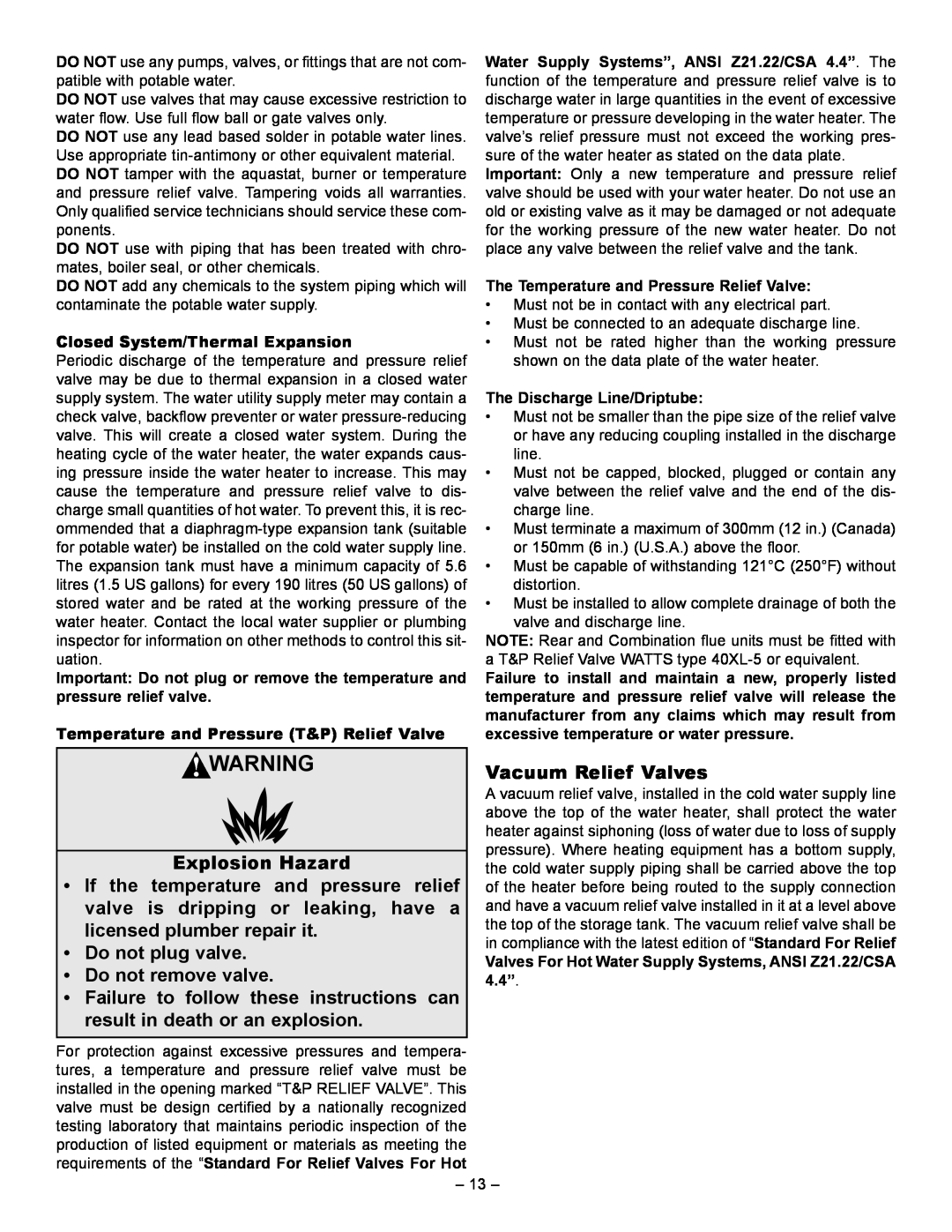
DO NOT use any pumps, valves, or fittings that are not com- patible with potable water.
DO NOT use valves that may cause excessive restriction to water flow. Use full flow ball or gate valves only.
DO NOT use any lead based solder in potable water lines. Use appropriate
DO NOT use with piping that has been treated with chro- mates, boiler seal, or other chemicals.
DO NOT add any chemicals to the system piping which will contaminate the potable water supply.
Closed System/Thermal Expansion
Periodic discharge of the temperature and pressure relief valve may be due to thermal expansion in a closed water supply system. The water utility supply meter may contain a check valve, backflow preventer or water
Important: Do not plug or remove the temperature and pressure relief valve.
Temperature and Pressure (T&P) Relief Valve
Water Supply Systems”, ANSI Z21.22/CSA 4.4”. The function of the temperature and pressure relief valve is to discharge water in large quantities in the event of excessive temperature or pressure developing in the water heater. The valve’s relief pressure must not exceed the working pres- sure of the water heater as stated on the data plate.
Important: Only a new temperature and pressure relief valve should be used with your water heater. Do not use an old or existing valve as it may be damaged or not adequate for the working pressure of the new water heater. Do not place any valve between the relief valve and the tank.
The Temperature and Pressure Relief Valve:
•Must not be in contact with any electrical part.
•Must be connected to an adequate discharge line.
•Must not be rated higher than the working pressure shown on the data plate of the water heater.
The Discharge Line/Driptube:
•Must not be smaller than the pipe size of the relief valve or have any reducing coupling installed in the discharge line.
•Must not be capped, blocked, plugged or contain any valve between the relief valve and the end of the dis- charge line.
•Must terminate a maximum of 300mm (12 in.) (Canada) or 150mm (6 in.) (U.S.A.) above the floor.
•Must be capable of withstanding 121°C (250°F) without distortion.
•Must be installed to allow complete drainage of both the valve and discharge line.
NOTE: Rear and Combination flue units must be fitted with a T&P Relief Valve WATTS type
Failure to install and maintain a new, properly listed temperature and pressure relief valve will release the manufacturer from any claims which may result from excessive temperature or water pressure.
![]() WARNING
WARNING
Explosion Hazard
•If the temperature and pressure relief valve is dripping or leaking, have a licensed plumber repair it.
•Do not plug valve.
•Do not remove valve.
•Failure to follow these instructions can result in death or an explosion.
For protection against excessive pressures and tempera- tures, a temperature and pressure relief valve must be installed in the opening marked “T&P RELIEF VALVE”. This valve must be design certified by a nationally recognized testing laboratory that maintains periodic inspection of the production of listed equipment or materials as meeting the requirements of the “Standard For Relief Valves For Hot
Vacuum Relief Valves
A vacuum relief valve, installed in the cold water supply line above the top of the water heater, shall protect the water heater against siphoning (loss of water due to loss of supply pressure). Where heating equipment has a bottom supply, the cold water supply piping shall be carried above the top of the heater before being routed to the supply connection and have a vacuum relief valve installed in it at a level above the top of the storage tank. The vacuum relief valve shall be in compliance with the latest edition of “Standard For Relief
Valves For Hot Water Supply Systems, ANSI Z21.22/CSA 4.4”.
– 13 –
